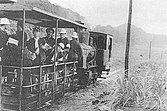Rail transport in the Mariana Islands
The rail traffic on the Marianas played only until the end of the Second World War for the transport of sugar cane and of military supplies a role.
Saipan
The Japanese businessman Haruji Matsue brought sugar cane and the narrow-gauge railways necessary for transport on the plantations to Saipan in the 1920s . Its narrow-gauge railway with a gauge of 760 mm (2 feet 5 15 ⁄ 16 inches ), which was used by the Japanese mainly for the transport of sugar cane and military supplies until the Second World War , circled the island almost on its entire perimeter. Along the 88 km long route there were stops in Kalapera, Banaderu, Matansa, Tanapag, Garapan, Charankanoa, Aslito and Rawau.
The US landing commandos used them after they captured the island. They used a diesel locomotive and three steam locomotives and repaired 100 flat cars. The reopening of the railway line from Charan-Kanoa to Aslito airfield, which had been damaged in the fighting, was carried out by a US Seabee command of the 4th Marine Division under its commander Lt. Comdr. William G. Byrne of Butte, Montana. He had focused on the seizure and military use of the railroad since seeing it on a map, and was lucky that the former operators hadn't sabotaged their 160-kilometer-long rail network and rolling stock. The Seabees took over nine locomotives, three of which were running by July 22, 1944, four others were repaired, but two could not be put back into service.

The railway was operated by the 1398 th Engineer Construction Batallion. At the end of July 1944 the traffic was 150 ton-miles (240 ton-kilometers) per day. The rail transport proved to be unfavorable overall, so that the rails were dismantled and a road was built on their route with the associated right of way . Two of the steam locomotive boilers were then successfully used to sterilize garbage cans. An Orenstein & Koppel Narrow Gauge Steam Locomotive is still on display today as a memorial in Sugar King Park, Garapan, Saipan.
Rota and Tinian
After Haruji Matsue built an NKK alcohol and ice cream factory on Saipan in 1925 and planted more than 3000 hectares of sugar cane, he set up similar facilities on the neighboring islands of Rota and Tinian . All sugar cane plantations had their own narrow-gauge railway. The sugar factories were destroyed during the Second World War and then not rebuilt. A steam locomotive has been preserved on the island of Rota as a monument to the sugar cane railways.
Guam
Two Japanese narrow-gauge diesel locomotives were parked on wooden beams on October 5, 1944 at the airfield on the Orote Peninsula in Guam. They were used as cover during the fighting and were badly damaged. It is not known whether they were previously used for rail transport or were only recently delivered. No railroad tracks on the peninsula are shown in maps from this period.
Individual evidence
- ↑ Utah Orem: Sugar King Park - Small but Interesting, Saipan Travel Reviews. In: TripAdvisor. November 17, 2017, accessed August 1, 2018 .
- ^ A b c d Karl C. Dod: The Corps of Engineers: The War Against Japan. Government Printing Office, 1966, pp. 503–503 , accessed August 1, 2018 .
- ^ Douglas C. Bailey: (Sugar) No. Unknown, Garapan, Mariana Islands. In: steamlocomotive.info. Retrieved August 1, 2018 .
- ^ Jim Fergusson: Fiji & Pacific Islands Railways, Passenger Stations & Stops. (pdf, 298 kB) In: railwaystationlists.co.uk. January 20, 2016, accessed October 3, 2018 .
- ^ John BT Campbell Jr.: Captured Saipan Railroad Now Managed By Seabees. In: Marine Corps Chevron. July 22, 1944, accessed August 1, 2018 .
- ^ History of the 1398 th Engineering Construction Ballallion. Quoted by Karl C. Dod.
- ↑ Col. Brown's comments on the manuscript of Karl C. Dod's book, EHD-Akten.
- ^ A b Glyn Williams: Railways in the Northern Mariana Islands. In: sinfin.net. August 21, 2017, accessed August 1, 2018 .
- ↑ C. Peter Chen: Japanese narrow gauge railroad locomotive at the Orote Peninsula Airfield, Guam, Mariana Islands, 5 Oct 1944. In: United States National Archives. Identification Code: 80-G-247812, accessed August 1, 2018 .
-
↑ Capture of Orote Penninsula, 25-30 July 1944. (jpg, 99 kB) In: Cyril J. O'Brien: Liberation: Marines in the Recapture of Guam. US National Park Service, accessed October 3, 2018 . Capture of Orote Penninsula. (jpg, 477 kB) In: OR Lodge: Drive to the FBL. In: The Recapture of Guam. 1954, accessed August 1, 2018 .




